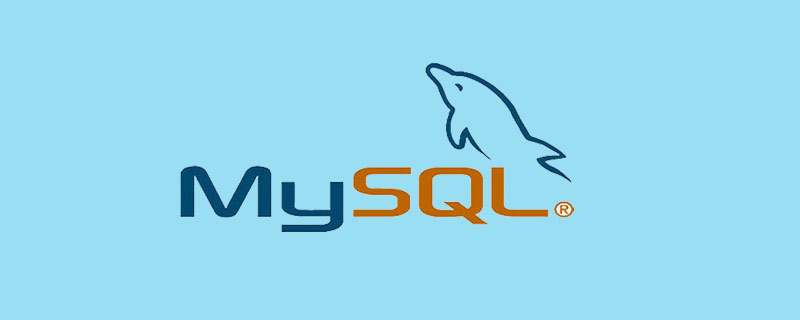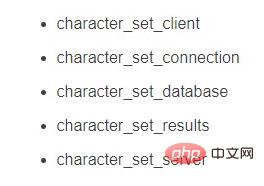How to deal with Japanese garbled characters in mysql
Mysql Japanese garbled solution: 1. When creating a table in the database, choose to sort it into "utf8_general_ci"; 2. When accessing the database in PHP, add the "mysql_query("SET NAMES UTF8");" statement That’s it.

The operating environment of this tutorial: Windows 10 system, MySQL version 5.7, Dell G3 computer.
What should I do if mysql has Japanese garbled characters?
mysql Japanese field garbled problem
1 When creating the database table, choose to sort it into
utf8_general_ci
2 When accessing the database with php, add
mysql_query("SET NAMES UTF8");Related expansion:
After logging in to MySQL, enter the following command to query the database code,
show variables like "char%";
You can get the following query results,

The information contained in the query results is as follows,
①character_set_client: utf8, which means that the MySQL client uses utf8 encoding, that is: for the SQL request content that the MySQL client will send to the MySQL server, the client will use UTF8 character set encoding rules are used to encode and send.
PS: Usually, when performing SQL queries in the command line window (CMD), if the result set contains Chinese characters, garbled characters will be displayed. This is because CMD, as the MySQL client, adopts the GBK encoding format by default at this time. , and the MySQL server sends data in utf8 encoding format, resulting in garbled characters.
②character_set_connection: utf8, indicating that the utf8 encoding format is used when connecting to the MySQL database;
③character_set_database: utf8, indicating that the utf8 encoding format is used by default when creating the MySQL database;
④character_set_results :utf8, indicates the encoding format used when the database returns query results to the client;
⑤character_set_server: utf8, indicates the default encoding format used when the MySQL server is installed, and artificial modification is not recommended;
⑥character_set_system: utf8, which represents the encoding format used by the database system. It is the encoding format used when storing metadata and does not need to be set;
⑦character_set_dir: Points to the directory location where the character set is installed.
Among them, the three system variables will not affect the problem of garbled characters, including: character_set_filesystem, character_set_system, character_set_dir. You only need to pay attention to whether the other variables meet the requirements.

Recommended study: "MySQL Video Tutorial"
The above is the detailed content of How to deal with Japanese garbled characters in mysql. For more information, please follow other related articles on the PHP Chinese website!

Hot AI Tools

Undresser.AI Undress
AI-powered app for creating realistic nude photos

AI Clothes Remover
Online AI tool for removing clothes from photos.

Undress AI Tool
Undress images for free

Clothoff.io
AI clothes remover

AI Hentai Generator
Generate AI Hentai for free.

Hot Article

Hot Tools

Notepad++7.3.1
Easy-to-use and free code editor

SublimeText3 Chinese version
Chinese version, very easy to use

Zend Studio 13.0.1
Powerful PHP integrated development environment

Dreamweaver CS6
Visual web development tools

SublimeText3 Mac version
God-level code editing software (SublimeText3)

Hot Topics
 PHP's big data structure processing skills
May 08, 2024 am 10:24 AM
PHP's big data structure processing skills
May 08, 2024 am 10:24 AM
Big data structure processing skills: Chunking: Break down the data set and process it in chunks to reduce memory consumption. Generator: Generate data items one by one without loading the entire data set, suitable for unlimited data sets. Streaming: Read files or query results line by line, suitable for large files or remote data. External storage: For very large data sets, store the data in a database or NoSQL.
 How to optimize MySQL query performance in PHP?
Jun 03, 2024 pm 08:11 PM
How to optimize MySQL query performance in PHP?
Jun 03, 2024 pm 08:11 PM
MySQL query performance can be optimized by building indexes that reduce lookup time from linear complexity to logarithmic complexity. Use PreparedStatements to prevent SQL injection and improve query performance. Limit query results and reduce the amount of data processed by the server. Optimize join queries, including using appropriate join types, creating indexes, and considering using subqueries. Analyze queries to identify bottlenecks; use caching to reduce database load; optimize PHP code to minimize overhead.
 How to use MySQL backup and restore in PHP?
Jun 03, 2024 pm 12:19 PM
How to use MySQL backup and restore in PHP?
Jun 03, 2024 pm 12:19 PM
Backing up and restoring a MySQL database in PHP can be achieved by following these steps: Back up the database: Use the mysqldump command to dump the database into a SQL file. Restore database: Use the mysql command to restore the database from SQL files.
 How to insert data into a MySQL table using PHP?
Jun 02, 2024 pm 02:26 PM
How to insert data into a MySQL table using PHP?
Jun 02, 2024 pm 02:26 PM
How to insert data into MySQL table? Connect to the database: Use mysqli to establish a connection to the database. Prepare the SQL query: Write an INSERT statement to specify the columns and values to be inserted. Execute query: Use the query() method to execute the insertion query. If successful, a confirmation message will be output.
 How to fix mysql_native_password not loaded errors on MySQL 8.4
Dec 09, 2024 am 11:42 AM
How to fix mysql_native_password not loaded errors on MySQL 8.4
Dec 09, 2024 am 11:42 AM
One of the major changes introduced in MySQL 8.4 (the latest LTS release as of 2024) is that the "MySQL Native Password" plugin is no longer enabled by default. Further, MySQL 9.0 removes this plugin completely. This change affects PHP and other app
 How to use MySQL stored procedures in PHP?
Jun 02, 2024 pm 02:13 PM
How to use MySQL stored procedures in PHP?
Jun 02, 2024 pm 02:13 PM
To use MySQL stored procedures in PHP: Use PDO or the MySQLi extension to connect to a MySQL database. Prepare the statement to call the stored procedure. Execute the stored procedure. Process the result set (if the stored procedure returns results). Close the database connection.
 How to create a MySQL table using PHP?
Jun 04, 2024 pm 01:57 PM
How to create a MySQL table using PHP?
Jun 04, 2024 pm 01:57 PM
Creating a MySQL table using PHP requires the following steps: Connect to the database. Create the database if it does not exist. Select a database. Create table. Execute the query. Close the connection.
 The difference between oracle database and mysql
May 10, 2024 am 01:54 AM
The difference between oracle database and mysql
May 10, 2024 am 01:54 AM
Oracle database and MySQL are both databases based on the relational model, but Oracle is superior in terms of compatibility, scalability, data types and security; while MySQL focuses on speed and flexibility and is more suitable for small to medium-sized data sets. . ① Oracle provides a wide range of data types, ② provides advanced security features, ③ is suitable for enterprise-level applications; ① MySQL supports NoSQL data types, ② has fewer security measures, and ③ is suitable for small to medium-sized applications.






